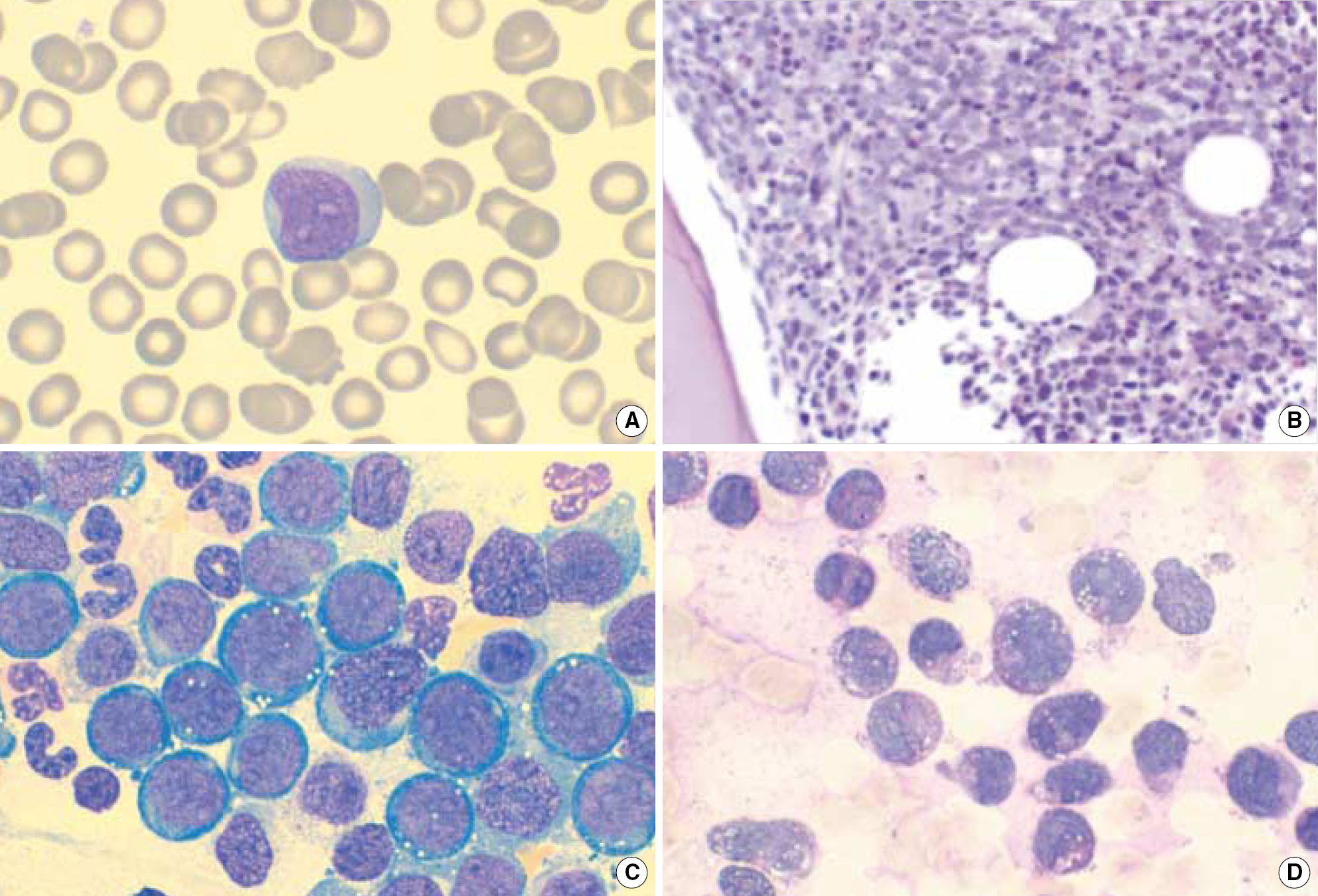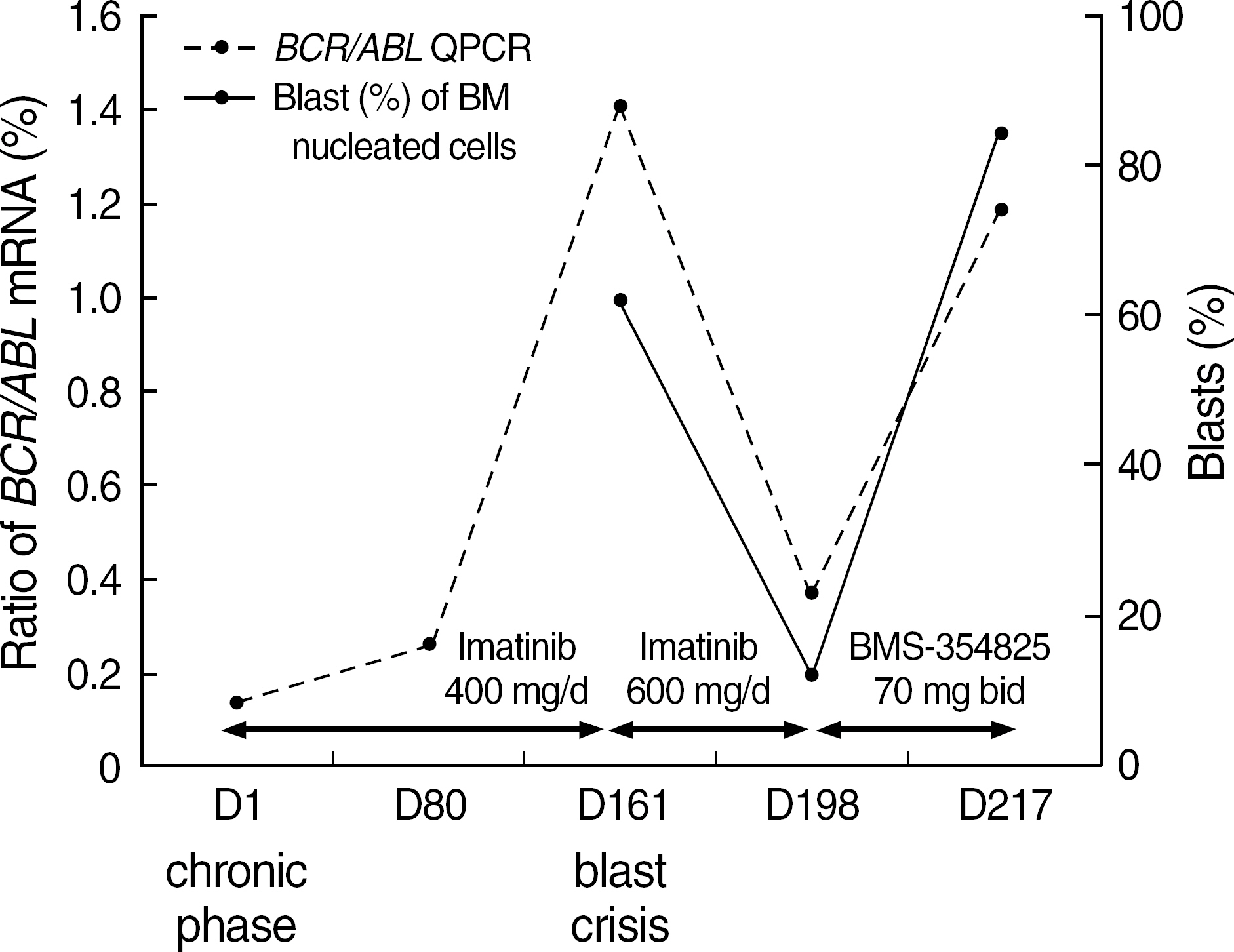Korean J Lab Med.
2006 Aug;26(4):255-262. 10.3343/kjlm.2006.26.4.255.
Erythroleukemic Blast Crisis of Chronic Myeloid Leukemia
- Affiliations
-
- 1Department of Laboratory Medicine, University of Ulsan College of Medicine and Asan Medical Center, Seoul, Korea. hschi@amc.seoul.kr
- 2Department of Internal Medicine, University of Ulsan College of Medicine and Asan Medical Center, Seoul, Korea.
- KMID: 2238832
- DOI: http://doi.org/10.3343/kjlm.2006.26.4.255
Abstract
- Erythroleukemic blast crisis of chronic myeloid leukemia (CML) is very rare. We report two cases of erythroleukemic blast crisis of CML resistant to imatinib treatment. Both patients made a rapid progression to blast crisis 6 and 4 months after diagnosis while being treated with imatinib 400 mg/day. Bone marrow aspiration revealed predominant erythroid precursors with 65.4% and 54.8% each. There were significant proportions (more than 20%) of myeloblasts among non-erythroid cells. Immunophenotyping revealed expression of glycophorin A confirming erythroleukemic blast crisis. The karyotyping result of patient 1 was 46,XX,t(9;22)(q34;q11.2)[3]/52,idem,+8,+12,+18,+21,+22,+der(22)t(9;22)[17] and that of patient 2 was 46,XX,inv(3)(q21q26.2),t(9;22)(q34;q11.2)[20]. Patient 1 showed no response to imatinib and BMS-354825 in the following bone marrow study. She died of septic shock as a complication of an infection after 69 days of blast crisis. Patient 2 received allogeneic bone marrow transplantation (BMT) in the cytogenetically no response state, but she also died of graft-versus-host disease 9 weeks after BMT. The poor prognosis and rapid progression of disease in both cases were correspondent to most of the reported cases. During the course of the disease of the two patients, we monitored the BCR-ABL chimeric mRNA with real-time quantitative polymerase chain reaction (RT-PCR), and it was found useful in predicting the imatinib response and progression to blast crisis of CML. Although both of our cases showed the typical bad prognosis and findings of erythroleukemic blast crisis of CML, the karyotypes were different from the expected type of t(3;21)(q26;q22). But the relationship between additional changes of EVI1 on chromosome 3q26 shown in case 2, and progression to the erythroleukemic blast crisis need further investigation.
MeSH Terms
-
Blast Crisis*
Bone Marrow
Bone Marrow Transplantation
Diagnosis
Glycophorin
Graft vs Host Disease
Granulocyte Precursor Cells
Humans
Immunophenotyping
Karyotype
Karyotyping
Leukemia, Myelogenous, Chronic, BCR-ABL Positive*
Polymerase Chain Reaction
Prognosis
RNA, Messenger
Shock, Septic
Dasatinib
Imatinib Mesylate
Glycophorin
RNA, Messenger
Figure
Reference
-
References
1. Komatsu N, Yoshida N, Tsuboyama A, Sato Y, Sakamoto S, Miura Y. Promyelocytic crisis of chronic myelogenous leukemia: coagulopathy similar to atypical disseminated intravascular coagulation in acute promyelocytic leukemia. Nippon Ketsueki Gakkai Zasshi. 1986; 49:894–9.2. Peterson LC, Bloomfield CD, Brunning RD. Blast crisis as an initial or terminal manifestation of chronic myeloid leukemia. A study of 28 patients. Am J Med. 1976; 60:209–20.3. Kantarjian HM, Keating MJ, Talpaz M, Walters RS, Smith TL, Cork A, et al. Chronic myelogenous leukemia in blast crisis. Analysis of 242 patients. Am J Med. 1987; 83:445–54.4. Castaigne S, Berger R, Jolly V, Daniel MT, Bernheim A, Marty M, et al. Promyelocytic blast crisis of chronic myelocytic leukemia with both t(9;22) and t(15;17) in M3 cells. Cancer. 1984; 54:2409–13.
Article5. Yasukawa M, Iwamasa K, Kawamura S, Murakami S, Takada K, Hato T, et al. Phenotypic and genotypic analysis of chronic myelogenous leukaemia with T lymphoblastic and megakaryoblastic mixed crisis. Br J Haematol. 1987; 66:331–6.
Article6. Rosenthal S, Cancellos GP, Gralnick HP. Erythroblastic transformation of chronic granulocytic leukemia. Am J Med. 1977; 63:116–24.
Article7. Guo JQ, Lian J, Glassman A, Talpaz M, Kantarjian H, Deisseroth AB, et al. Comparison of bcr-abl protein expression and Philadelphia chromosome analyses in chronic myelogenous leukemia patients. Am J Clin Pathol. 1996; 106:442–8.8. Hjorth M, Mark J, Tibblin E. A hypotriploid stemline with 4 Ph1 chromosomes in erythroleukemic blast crisis of a CML-patient with a long survival time. Hereditas. 1980; 93:333–6.
Article9. Sadamori N, Ikeda S, Muta T, Ichimaru M, Matsunaga M. Erythroblastic transformation of Philadelphia chromosome (Ph1)-positive chronic myelogenous leukemia associated with marked chromosomal rearrangements. Cancer Genet Cytogenet. 1981; 3:353–7.
Article10. Ekblom M, Borgstrom G, von Willebrand E, Gahmberg CG, Vuopio P, Andersson LC. Erythroid blast crisis in chronic myelogenous leukemia. Blood. 1983; 62:591–6.
Article11. Kim JY, Kim MS, Lim JH, Han KJ. Two Cases of Erythroleukemic Blast Crisis in Chronic Myelogenous Leukemia. Korean J Clin Pathol. 2001; 21:93–7.12. Hochhaus A, Weisser A, La Rosee P, Emig M, Muller MC, Saussele S, et al. Detection and quantification of residual disease in chronic myelogenous leukemia. Leukemia. 2000; 14:998–1005.
Article13. Heisterkamp N, Stam K, Groffen J, de Klein A, Grosveld G. Structural organization of the bcr gene and its role in the Ph' translocation. Nature. 1985; 315:758–61.14. Parkin JL, McKenna RW, Brunning RD. Philadelphia chromosome-positive blastic leukaemia: ultrastructural and ultracytochemical evidence of basophil and mast cell differentiation. Br J Haematol. 1982; 52:663–77.
Article15. Rosenthal S, Canellos GP, DeVita VT Jr, Gralnick HR. Characteristics of blast crisis in chronic granulocytic leukemia. Blood. 1977; 49:705–14.
Article16. Saikia T, Advani S, Dasgupta A, Ramakrishnan G, Nair C, Gladstone B, et al. Characterisation of blast cells during blastic phase of chronic myeloid leukaemia by immunophenotyping–experience in 60 patients. Leuk Res. 1988; 12:499–506.
Article17. Hernandez JM, Gonzalez-Sarmiento R, Martin C, Gonzalez M, Sanchez I, Corral J, et al. Immunophenotypic, genomic and clinical characteristics of blast crisis of chronic myelogenous leukaemia. Br J Haematol. 1991; 79:408–14.
Article18. Domingo-Claros A, Larriba I, Rozman M, Irriguible D, Vallespi T, Aventin A, et al. Acute erythroid neoplastic proliferations. A biological study based on 62 patients. Haematologica. 2002; 87:148–53.19. Vardiman JW, Burnning RD, Harris NL, editors. ed.Chronic Myeloproliferative diseases. Chapter 1.Washington D.C.: Lyan: IARC Press;2001. p. 15–44.20. Garand R, Duchayne E, Blanchard D, Robillard N, Kuhlein E, Fenneteau O, et al. Minimally differentiated erythroleukaemia (AML M6 ‘variant’): a rare subset of AML distinct from AML M6. Groupe Francais d'Hematologie Cellulaire. Br J Haematol. 1995; 90:868–75.21. Park S, Picard F, Dreyfus F. Erythroleukemia: a need for a new definition. Leukemia. 2002; 16:1399–401.
Article22. O'Hare T, Walters DK, Stoffregen EP, Jia T, Manley PW, Mestan J, et al. In vitro activity of Bcr-Abl inhibitors AMN107 and BMS-354825 against clinically relevant imatinib-resistant Abl kinase domain mutants. Cancer Res. 2005; 65:4500–5.23. Killick S, Matutes E, Powles RL, Min T, Treleaven JG, Rege KP, et al. Acute erythroid leukemia (M6): outcome of bone marrow transplantation. Leuk Lymphoma. 1999; 35:99–107.
Article24. Choi SJ, Chi HS, Seo EJ, Park CJ. Monitoring of bcr-abl fusion transcript levels by quantitative real-time polymerase chain reaction in chronic myeloid leukemia after bone marrow transplantation. Korean J Lab Med. 2003; 23:221–8.
- Full Text Links
- Actions
-
Cited
- CITED
-
- Close
- Share
- Similar articles
-
- Two Cases of Erythroleukemic Blast Crisis in Chronic Myelogenous Leukemia
- Two Cases of Chronic Myeloid Leukemia in Lymphoid Blast Phase Presented as Philadelphia-Positive Acute Lymphoblastic Leukemia
- A Case of Myeloid Blast Crisis of Atypical Chronic Myelogenous Leukemia
- Pediatric chronic myeloid leukemia with B-cell lymphoid blast crisis at presentation
- A Case of Myeloid Blast Crisis of Ph-positive Chronic Myeloid Leukemia with t(3;21)(q26;q22)






